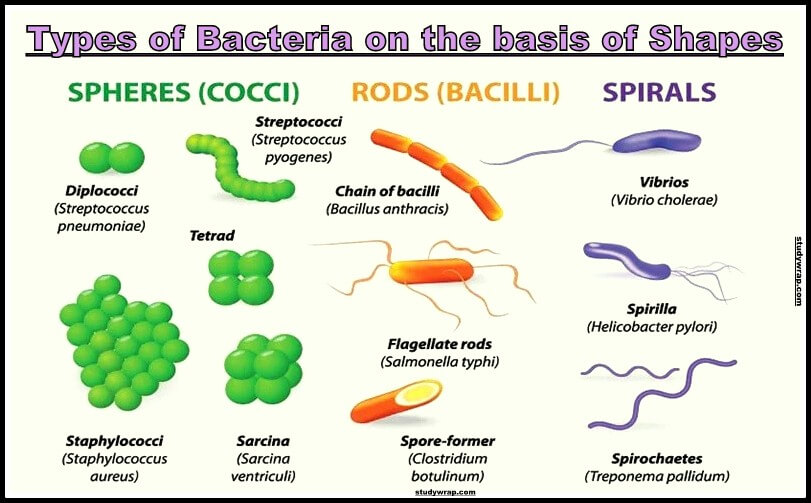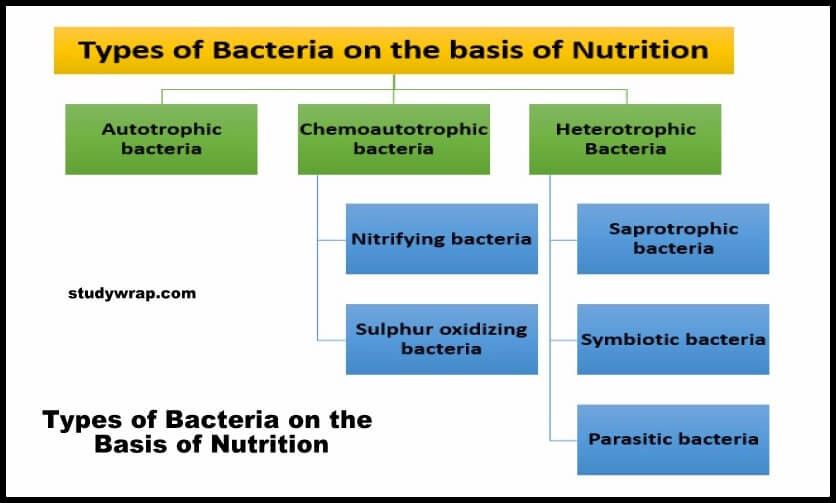Types of Bacteria on basis of Shape, Nutrition & Respiration
Types of Bacteria on the basis of Shape, Nutrition and Respiration
Table of Contents
· Bacteria are of Different Shapes and Sizes. They can be further classified on the basis of –
· Shapes
· Nutrition
· Mode of Respiration
· Types of Stain they retain
Types of Bacteria on the basis of Shapes
· Bacteria are found in numerous shapes which can be classified into four basic forms or shapes.
· They are – Spherical (Cocci), Rod (Bacilli), Vibrio (Comma) and Spiral (spring).
· Most of bacteria have a particular shapes that are characteristic feature of that bacterial species, some species have pleomorphic cell type (i.e., these can exhibit a variety of shapes), Eg. – Rhizobium leguminosarum.

· Types of Bacteria on the basis of Shape have been divided into six types-
Coccus
· These are spherical or ellipsoidal in shape and aflagellate. They are sub-divided into six groups on the basis of cell arrangement –
-
-
-
- Monococcus – occur singly. Eg. – Micrococcus luteus, M. roseus.
- Diplococcus – occur in pairs. Eg. – Meningococcus, Gonococcus
- Tetracoccus – occur in groups of 4. Eg. – Neisseria
- Streptococcus – occur in chains. Eg. – Streptococcus lactis
- Sarcinae – occur in cubical forms of 8 in 3 dimensional Structure. Eg. – Sarcina lutae.
- Staphylococcus – occur in clusters like grapes. Eg. – Staphylococcus aureus.
-
-
Bacilli
· Rod-like forms, either singly or may be arranged differently. They are generally flagellate. It is the most common of all the shapes. These are of following types –
-
-
-
- Monobacillus – The bacteria occur singly, Eg. – Bacillus anthracis, Lactobacillus.
- Diplobacillus – Bacteria are arranged in pairs.
- Streptobacillus – Bacteria form a chain of rods, Eg. – Streptobacillus.
- Palisade-like – If the cells are lined side by side like match sticks and at angles to one another. Eg. – Corynebacterium diphtheriae.
-
-
Spirilla
· Coiled forms of bacteria exhibiting twists with one or more turns, e.g., Spirillum, Spirochaete.
Vibrios
· These are comma shaped bacteria, e.g., Vibrio cholerae.
Stalked
· The bacterium possesses a stalk, e.g., Caulobacter.
Budding
· The bacterium is swollen at places, e.g., Rhodomicrobium.
Types of Bacteria on the basis of Nutrition
· Bacteria show both Autotrophic and Heterotrophic nutrition.
· Autotrophic nutrition consists of manufacture of organic materials from inorganic raw materials with the help of energy obtained from outside sources.
· It is of two types, Chemosynthesis and Photosynthesis. The bacteria performing these modes of nutrition are respectively called chemoautotrophs and photoautotrophs.
· Heterotrophic nutrition involves the obtaining of readymade organic nutrients from outside sources. It is of further three types – Saprotrophic, Symbiotic and Parasitic.

Autotrophic bacteria
· They are capable of entrapping solar energy and utilizing it for the synthesis of complex food materials.
· The bacteria possess photosynthetic pigments of two types, Bacteriochlorophyll (bacteriopurpurin) and Bacterioviridin (chlorobium chlorophyll).
· No oxygen is evolved in bacterial photosynthesis. Such type of photosynthesis is known as anoxygenic photosynthesis.
· Water is not used as a source of reducing power. Instead, hydrogen is obtained either directly (some purple bacteria) or from various types of inorganic and organic compounds, e.g., H2S (green bacteria), aliphatic compounds (purple non-sulphur bacteria).
Chemoautotrophic bacteria
· Bacteria belonging to this category obtain energy for the synthesis of food oxidizing certain inorganic substances like ammonia, nitrates, ferrous ions etc. Thus, they do not utilize light as energy source. The chemical energy thus obtained, is trapped in ATP molecules.
· They play a great role in recycling nutrients like hydrogen, phosphorus, iron, sulphur.
Nitrifying bacteria
· They obtain energy by oxidising ammonia to nitrite. e.g. Nitrosomonas and Nitrosococcus
NH3 + 202 → N02 + 2H20 + Energy
· Nitrocystis and Nitrobacteroxidise nitrites to nitrates.
2N02 + 02 → 2N03 + Energy
Sulphur oxidizing bacteria
· They oxidises hydrogen sulphide to sulphur in order to obtain energy for chemosynthesis. e.g. Beggiatoa
2H2S + 02 → 2S + 2H20 + Energy
· Thiobacillus thioxidans, another Sulphur bacterium, oxidises sulphur to sulphate state.
2S + 2H20 + 302 → 2H2S04 + Energy
Heterotrophic Bacteria
Saprotrophic bacteria
· They are free living bacteria which obtain their food from organic remains, e.g., corpses, animal excreta, fallen leaves, vegetables, fruits, meat, jams, jellies, bread and other products of plant and animal origin.
Symbiotic bacteria
· These bacteria live in mutually beneficial association with other organisms. Enteric bacterium Escherichia coli, lives as a symbiont in human intestine.
Parasitic bacteria
· These bacteria live in contact with other living beings for obtaining nourishment or special organic compounds required for growth (growth factors) e.g., Vibrio cholerae.
Types of Bacteria on the basis of Respiration
· According to the mode of respiration, bacteria can be aerobic or anaerobic. Each of them is further of two types, obligate and facultative.
Obligate aerobes
· They are bacteria which can respire only aerobically as they have the enzyme system for aerobic respiration only. In the absence of oxygen, they fail to respire and die, Eg. Bacillus subtilis.
Facultative aerobes
· They are bacteria which respire anaerobically under normal conditions but can respire aerobically when oxygen is available. Most of the photosynthetic bacteria belong to this group. Eg. Chlorobium.
Facultative anaerobes
· They are bacteria which generally respire aerobically but switch over to anaerobic mode of respiration if oxygen becomes deficient. Eg. Pseudomonas.
Obligate anaerobes
· The bacteria of this category respire only anaerobically. This respiration liberates much less amount of energy as compared to aerobic respiration. They lack enzymes that carry out aerobic respiration. Eg. Clostridium botulinum.
Types of Bacteria on the basis of Staining
· One of the unique components of cell wall of bacteria is peptidoglycan or mucopeptide or Murein (made of muco-polysaccharide + polypeptide). In peptidoglycan, NAG (N-acetyl glucosamine) and NAM (N-acetyl muramic acid) are joined by short peptide chains or cross bridges of amino acids.
· The cell walls of Gram Positive bacteria contain 60-90% peptidoglycan whereas cell walls of Gram Negative bacteria contain about 10% peptidoglycan.

Gram Positive bacteria
· In the cell wall of Gram Positive bacteria, both horizontal and vertical peptide linkages are present, due to which mesh is dense and hence the stain does not come out. Further outer layer of cell wall of Gram Positive bacteria is made of teichoic acid.
Gram Negative bacteria
· In the cell wall of Gram Negative bacteria, either horizontal or vertical peptide linkages are present, due to which mesh is loose, hence, stain comes out. Further outermost layer of cell wall of Gram Negative bacteria is made of lipopolysaccharides.
So, this was all about the Types of Bacteria on the basis of Shape, Nutrition, Staining & Respiration. In the Next Post (Click Here), we will discuss about Mode of Reproduction in Bacteria.
If you liked this post than please subscribe to our newsletter and like our Facebook page to get regular updates. You can read our more notes on Topic of Biological Classification Here.

